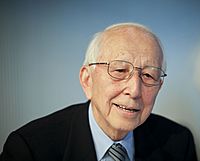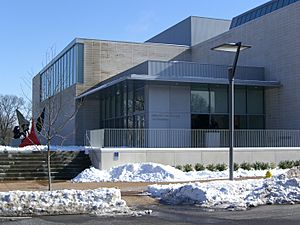Fumihiko Maki facts for kids
Quick facts for kids
Fumihiko Maki
|
|
|---|---|

Maki in 2010
|
|
| Born | 6 September 1928 |
| Died | 6 June 2024 (aged 95) |
| Alma mater | University of Tokyo (Bachelor of Architecture, 1952) Cranbrook Academy of Art (Master of Architecture, 1953) Graduate School of Design, Harvard University (Master of Architecture, 1954) |
| Occupation | Architect |
| Awards | Pritzker Prize AIA Gold Medal |
| Practice | Maki and Associates |
| Buildings | Yerba Buena Center for the Arts, Mildred Lane Kemper Art Museum, 4 World Trade Center |
| Projects | Expansion of the headquarters of the United Nations in Manhattan. |
Fumihiko Maki was a famous Japanese architect. He was born on September 6, 1928, and passed away on June 6, 2024. In 1993, he won the Pritzker Prize, which is like the Nobel Prize for architecture. His buildings often used new materials and blended ideas from both Eastern and Western cultures.
Contents
Early Life and Education
Maki was born in Tokyo, Japan. He loved learning about architecture from a young age.
Studying in Japan
He first studied at the University of Tokyo. He earned his Bachelor of Architecture degree there in 1952.
Studying in the United States
After finishing his studies in Japan, Maki moved to the United States. He went to the Cranbrook Academy of Art in Michigan. There, he earned a master's degree in 1953. He then continued his education at Harvard Graduate School of Design, getting another master's degree in architecture in 1954.
Maki's Amazing Career
Fumihiko Maki had a long and successful career designing buildings all over the world.
Starting in St. Louis
In 1956, Maki became a professor at Washington University in St. Louis. His very first building design was for Steinberg Hall, an art center on the university's campus. This was his only completed building in the U.S. for many years.
Returning to Japan
In 1960, Maki went back to Japan. He helped start a group called the Metabolism Group. This group explored new ideas about how cities and buildings could grow and change. He also worked for big architecture firms in New York City and Massachusetts. In 1965, he started his own company, Maki and Associates.
Important Projects in the U.S.
Maki's next big project in the U.S. was in 1993. He designed the Yerba Buena Center for the Arts in San Francisco. Later, in 2006, he returned to Washington University in St. Louis. He designed the new home for the Mildred Lane Kemper Art Museum and Walker Hall there.
Designing for the United Nations
Maki also worked on a huge project in New York City. He designed a large expansion for the headquarters of the United Nations. This project cost $330 million.
Building at the World Trade Center
After the UN project, Maki designed Tower 4 at the former World Trade Center site. This building opened in 2013. Many people thought it was a beautiful and impressive skyscraper.
International Work
Maki's work wasn't just in Japan and the U.S. He designed buildings in many other countries too.
- In 2006, he helped judge a competition for the new Gardens by the Bay in Singapore.
- He designed an extension for the MIT Media Lab in Massachusetts, which was finished in 2009.
- He designed buildings for the Aga Khan, including the Delegation of the Ismaili Imamat in Ottawa and the Aga Khan Museum in Toronto.
- He also designed the London campus of the Aga Khan University. This was his first project in Europe.
- Maki was also chosen to design the Museum Reinhard Ernst in Wiesbaden, Germany. This museum will show a collection of abstract art.
Famous Architectural Works

Maki was known for mixing modern building styles with traditional Japanese ideas. For example, he used a Japanese idea called oku. This is a way of arranging spaces that wind around a building. You can see this in the Shimane Museum of Ancient Izumo.
Here are some of his other well-known projects:
- Steinberg Hall at Washington University in St. Louis (1960s)
- Hillside Terrace in Tokyo (1969)
- Work at Expo '70 in Osaka (1970)
- St. Mary's International School in Tokyo (1971)
- Spiral in Tokyo (1985)
- Makuhari Messe in Chiba (1989)
- Tokyo Metropolitan Gymnasium in Tokyo (1991)
- Yerba Buena Center for the Arts in San Francisco (1993)
- TV Asahi Headquarters in Tokyo (2003)
- Republic Polytechnic in Singapore (2006)
- Delegation of the Ismaili Imamat in Ottawa (2008)
- MIT Media Lab Extension in Cambridge, Massachusetts (2009)
- Tower 4 in Manhattan (2013)
- Aga Khan Museum in Toronto (2014)
- Aga Khan Centre in London (2018)
Works in Progress
At the time of his passing, some of Maki's projects were still being built or planned:
- A new building for the United Nations in New York City.
- The new city hall of Yokohama, Japan.
- The Reinhard Ernst Museum in Wiesbaden, Germany.
Awards and Honors
Fumihiko Maki received many important awards for his amazing work:
- 1988: Wolf Prize in Arts
- 1993: Pritzker Architecture Prize (the highest honor in architecture)
- 1993: UIA Gold Medal
- 1999: Praemium Imperiale
- 2011: AIA Gold Medal
Gallery of Works
-
TV Asahi Headquarters, Tokyo (2003)
-
Aga Khan Museum, Toronto (2014)
See also
 In Spanish: Fumihiko Maki para niños
In Spanish: Fumihiko Maki para niños













